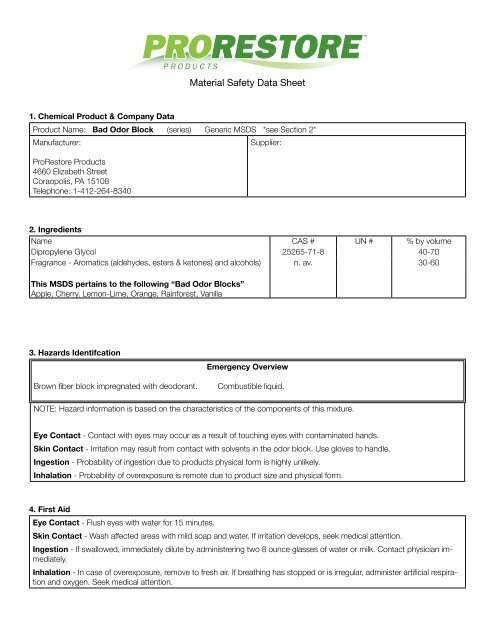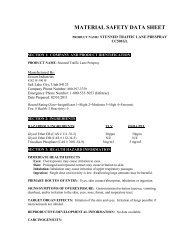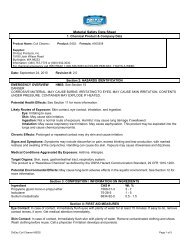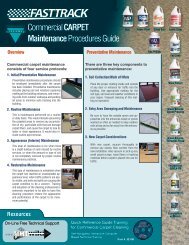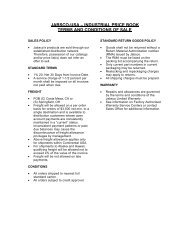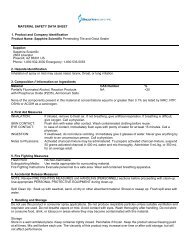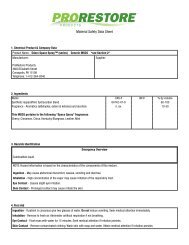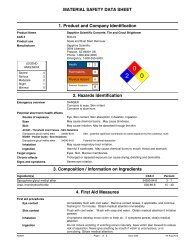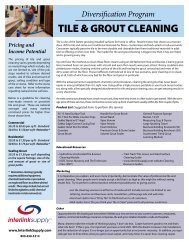MSDS - ProRestore Products
MSDS - ProRestore Products
MSDS - ProRestore Products
Create successful ePaper yourself
Turn your PDF publications into a flip-book with our unique Google optimized e-Paper software.
Material Safety Data Sheet<br />
1. Chemical Product & Company Data<br />
Product Name: Bad Odor Block (series) Generic <strong>MSDS</strong> *see Section 2*<br />
Manufacturer:<br />
<strong>ProRestore</strong> <strong>Products</strong><br />
4660 Elizabeth Street<br />
Coraopolis, PA 15108<br />
Telephone: 1-412-264-8340<br />
Supplier:<br />
2. Ingredients<br />
Name CAS # UN # % by volume<br />
Dipropylene Glycol 25265-71-8 40-70<br />
Fragrance - Aromatics (aldehydes, esters & ketones) and alcohols) n. av. 30-60<br />
This <strong>MSDS</strong> pertains to the following “Bad Odor Blocks”<br />
Apple, Cherry, Lemon-Lime, Orange, Rainforest, Vanilla<br />
3. Hazards Identifcation<br />
Brown fiber block impregnated with deodorant.<br />
Emergency Overview<br />
Combustible liquid.<br />
NOTE: Hazard information is based on the characteristics of the components of this mixture.<br />
Eye Contact - Contact with eyes may occur as a result of touching eyes with contaminated hands.<br />
Skin Contact - Irritation may result from contact with solvents in the odor block. Use gloves to handle.<br />
Ingestion - Probability of ingestion due to products physical form is highly unlikely.<br />
Inhalation - Probability of overexposure is remote due to product size and physical form.<br />
4. First Aid<br />
Eye Contact - Flush eyes with water for 15 minutes.<br />
Skin Contact - Wash affected areas with mild soap and water. If irritation develops, seek medical attention.<br />
Ingestion - If swallowed, immediately dilute by administrering two 8 ounce glasses of water or milk. Contact physician immediately.<br />
Inhalation - In case of overexposure, remove to fresh air. If breathing has stopped or is irregular, administer artificial respiration<br />
and oxygen. Seek medical attention.
Bad Odor Block<br />
5. Fire Fighting Measures<br />
Flammability<br />
Yes X No<br />
If yes, under which<br />
conditions?<br />
Combustible liquid. Potential fire hazard when exposed<br />
to excessive heat, flame or other souces of ignition.<br />
Flashpoint:<br />
*See Section 16*<br />
Autoignition temperature<br />
n. av.<br />
Upper flammable limit<br />
% by volume 5.0<br />
Hazardous combustion products<br />
Carbon monoxide and/or carbon dioxide<br />
Lower flammable limit<br />
% by volume 0.7<br />
Explosion data<br />
n. ap.<br />
Means of extinction:<br />
Apply alcohol type or all purpose foam for large fires. Use dry chemical media or carbon dioxide<br />
extinguishers for small fires. SCBA and bunker gear for fire department personnel.<br />
6. Accidental Release Measures<br />
Not applicable to product.<br />
7. Handling & Storage<br />
Use personal protective equipment (gloves) or barrier creams when handling odor blocks.<br />
Wash hands after handling odor blocks.<br />
Keep away from sources of ignition.<br />
8. Exposure Controls & Personal Protection<br />
Gloves<br />
Natural Rubber<br />
Footwear<br />
n. ap.<br />
Personal Protective Equipment<br />
Respirator<br />
n. ap.<br />
Clothing<br />
Coveralls or equivalent<br />
Exposure Guidelines<br />
Eye<br />
n. ap.<br />
Other<br />
n. ap.<br />
No published exposure guidelines by OSHA or ACGIH for this product or its ingredients.
Bad Odor Block<br />
9. Physical and Chemical Properties<br />
Physical state<br />
Liquid impregnated fiber block<br />
Odor threshold (ppm)<br />
Evaporation<br />
(butyl acetate = 1)<br />
pH<br />
Solubility in water<br />
n. av.<br />
n. av.<br />
n. av.<br />
n. av.<br />
Odor and appearance<br />
Brown colored fiber block, various odors (see Sec. 2)<br />
Vapor pressure (mm Hg)<br />
n. av.<br />
Boiling point<br />
Specific gravity<br />
Viscosity<br />
n. av.<br />
n. av.<br />
n. av.<br />
Vapor density (Air=1)<br />
Freezing point<br />
n. av.<br />
n. av.<br />
Coefficient water/oil distribution<br />
n. av.<br />
% Volatiles (by weight)<br />
30-50<br />
10. Stability and Reactivity<br />
Chemical Stability<br />
Yes X No<br />
Incompatibility with other substances<br />
Yes No X<br />
If no, under<br />
which conditions?<br />
If yes, under<br />
which conditions?<br />
Reactivity, and under<br />
what conditions?<br />
Hazardous decomposition<br />
products?<br />
None known.<br />
Carbon monoxide and/or carbon dioxide as combustion by-products.<br />
11. Toxicological Information<br />
Route of Entry<br />
Skin Contact X Skin Absorption Eye Contact Inhalation X Ingestion<br />
No toxicity studies have been conducted for the product.<br />
Dipropylene glycol LD50 (rat, oral) 1.49 g/kg<br />
Carcinogenicity<br />
No<br />
Synergistic products<br />
No<br />
Mutagenicity<br />
No<br />
Sensitization<br />
No<br />
Teratogenicity<br />
No<br />
Neurotoxicity<br />
No<br />
Reproductive toxicity<br />
No<br />
Target organs<br />
Skin<br />
12. Ecological Information<br />
None available for product or its component.
Bad Odor Block<br />
13. Disposal Considerations<br />
May be disposed of in a landfill site or incinerated<br />
14. Transport Information<br />
Shipping Name:<br />
Hazard Class:<br />
UN Identification #:<br />
Not Regulated For Ground Shipments In The US<br />
Note: BOB Cherry and Orange must ship as an ORM-D Ground in the US.<br />
15. Regulatory Information<br />
This material safety data sheet has been prepared in accordance with the requirements of the OSHA Hazard Communication<br />
Standard (29 CFR 1910.1200) and the Hazardous <strong>Products</strong> Act (Can.) and the Controlled <strong>Products</strong> Regulations (Can.)<br />
This product has been classified in accordance with the hazard criteria of the CPR (Can.) and the <strong>MSDS</strong> contains all the<br />
information required by the CPR (Can.).<br />
This product is classed as a solid containing a flammable liquid - 29 CFR 1910.1200 and Controlled <strong>Products</strong> Regulations<br />
(Can.)<br />
WHMIS classification B3<br />
This product is not subject to the reporting requirement of Section 313 of Title III of Superfund Amendments and Reauthorization<br />
Act (SARA) 1986 and 40 CFR part 372.<br />
16. Other Information<br />
Apple 160 °F (71.1 °C)<br />
*Cherry 134 °F (56.6 °C)<br />
Lemon-Lime 147 °F (63.8 °C)<br />
*Orange 118 °F (47.8 °C)<br />
Rainforest 180 °F (82 °C)<br />
Vanilla 165 °F (73.8 °C)<br />
For chemical emergency during transportation call INFOTRAC (US) 1-800-535-5053 (INT’L) 1-352-323-3500<br />
Prepared by: <strong>ProRestore</strong> <strong>Products</strong>, Coraopolis, PA / Cliff Zlotnik Phone No: 1-412-264-8340 Date: January 7, 2010<br />
Abbreviations:<br />
n. av. = not available n. ap. = not applicable ppm = parts per million<br />
mm Hg = millimeters of Mercury PMCC = Pensky Martens Closed Cup TCC = Tagliabue Closed Cup<br />
COC = Cleveland Open Cup TWA = Time Weighted Average STEL = Short Term Exposure Limit<br />
LD = Lethal Dose LC = Lethal Concentration CS = centistokes<br />
This information is furnished without warranty, expressed or implied except that it is accurate to the best knowledge of <strong>ProRestore</strong> <strong>Products</strong>. The data and information on this sheet relates only to the specific<br />
material designated herein. <strong>ProRestore</strong> Prducts assumes no legal responsibility for use or reliance upon this data.


